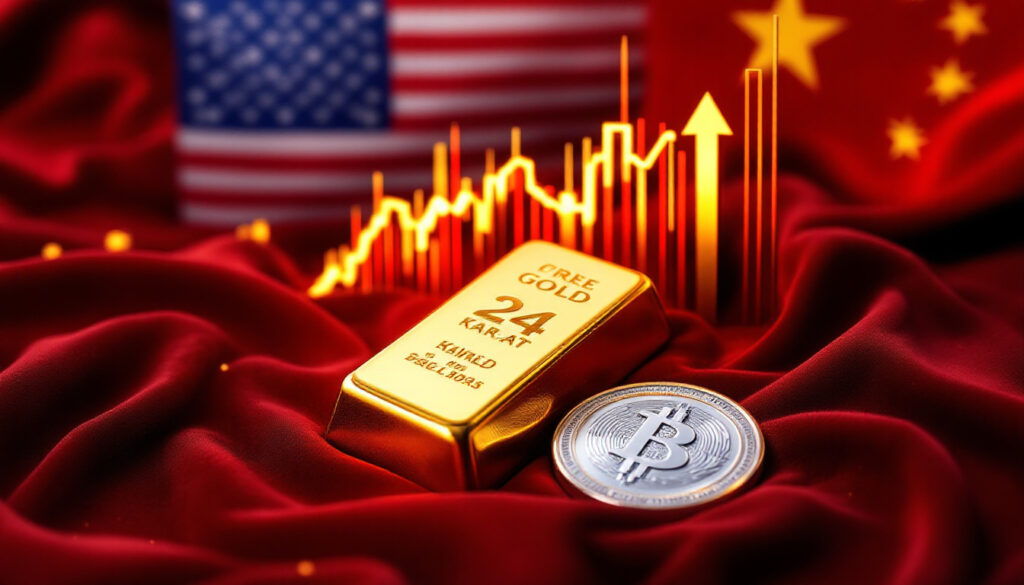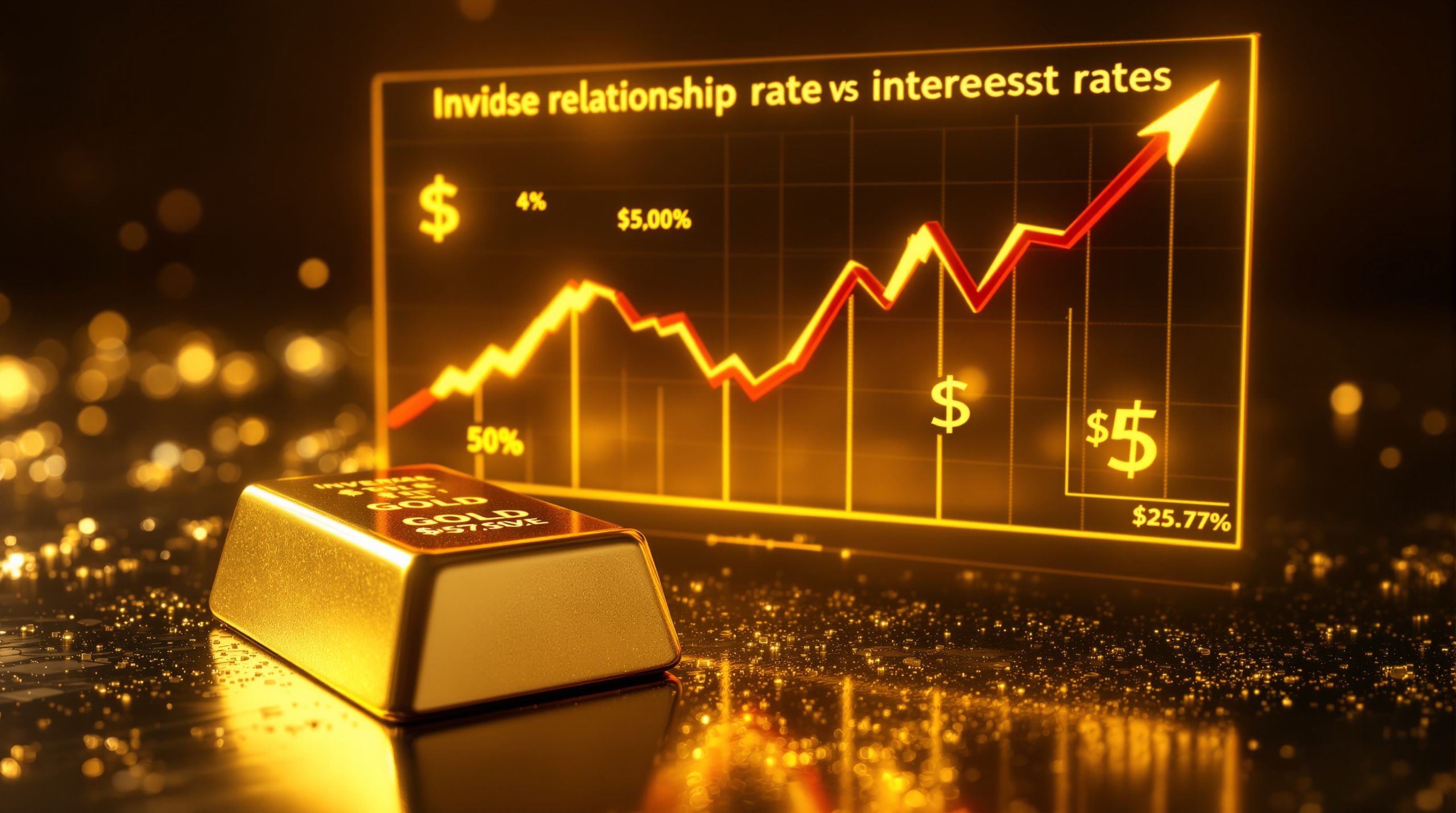How Are Tariffs Impacting Gold and Silver Markets?
Recent Price Movements in Precious Metals
Gold prices surged to $2,800 per ounce in March 2025, eclipsing previous records, while silver approached $35 per ounce—a 40% year-to-date increase. Despite a 5% correction following the U.S.-China tariff announcement, gold stabilized at $2,650, outperforming equity indices like the NASDAQ (-20%) and S&P 500 (-14%) during the same period. This resilience underscores gold's role as a hedge within investment portfolios, with institutional allocators increasingly adopting gold to improve Sharpe ratios. Silver's volatility, however, remains tied to industrial demand, which faces headwinds from tariff-driven manufacturing slowdowns.
Gold's drawdown during the May 2025 tariff announcement was less than 1% compared to equities' 14–20% decline. COMEX reported 18.7 metric tons of physical gold withdrawn in April 2025, signaling institutional accumulation. Meanwhile, silver's 30-day volatility index spiked to 32% in March 2025, double gold's 16%.
The Tariff Effect on Precious Metals
Tariffs act as value-destructive events, initially depressing asset prices across markets. However, gold's rapid recovery highlights its unique position as a non-correlated asset. Institutional buyers are "increasing allocations irrespective of price," driven by geopolitical uncertainty and currency devaluation risks. The $25–50 per-packet tariff on Chinese goods, effective June 2025, disproportionately impacts low-value imports, with e-commerce platforms like AliExpress facing 300–500% cost increases on shipments under $800.
A 10% gold allocation improved risk-adjusted returns by 22% in backtests of 60/40 portfolios. Additionally, tariffs may pressure the U.S. dollar's reserve status, elevating gold's appeal as a monetary alternative.
Global Response to U.S. Tariff Policies
The Trump administration's implementation of high tariffs on Chinese goods has triggered retaliatory measures, with China imposing 84% tariffs on U.S. goods and trade. This escalating trade war has created significant market uncertainty, benefiting safe-haven assets like gold. The new tariff structures include substantial fees on previously duty-free imports under $800, fundamentally altering the economics of international commerce.
Physical gold deliveries from COMEX have accelerated, indicating strong demand despite price volatility. This trend suggests sophisticated investors are positioning for continued economic uncertainty as tariff impacts ripple through global supply chains.
Why Are Central Banks Turning to Gold?
Shifting Reserve Asset Preferences
Central banks purchased 1,136 metric tons of gold in 2024—the highest annual total since 1967—amid concerns over U.S. fiscal policy and Treasury market liquidity. Geopolitical fragmentation has accelerated de-dollarization, with nations reevaluating reserve strategies after U.S. trade disputes.
Global gold reserves as a percentage of FX holdings reached 15.2% in 2025 compared to 8.6% in 2010. Simultaneously, U.S. Treasury holdings by G20 nations declined by $180 billion year-over-year, reflecting growing diversification away from dollar-denominated assets.
"Central banks don't care what price they pay for gold. It's about hedging against systemic risks," notes one banking expert. This perspective explains why many monetary authorities continue accumulating precious metals despite price increases.
The Case of Canada and Other Nations
Canada's position is particularly notable, as it holds virtually no gold reserves (less than 1 ton) despite being a major producer. Recent trade tensions with the United States may prompt Canadian monetary authorities to reconsider this stance, potentially joining other nations reducing their exposure to U.S. assets.
Switzerland presents an interesting counterexample in trade relations. Despite being accused of maintaining trade imbalances, Switzerland supports approximately one million U.S. jobs through bilateral trade. This complex relationship illustrates how simplistic tariff policies may overlook mutually beneficial economic partnerships.
What Economic Impacts Will Tariffs Have?
Consumer Price Effects
The $25–50 per-packet tariff could elevate consumer prices by 6–9%, particularly for electronics and textiles. Small businesses reliant on Alibaba imports face margin compression, with 45% of U.S. retailers reporting cost overruns in Q1 2025.
Consumers will experience direct impacts through higher prices at major retailers like Walmart, which sources significant inventory from China. The additional fees on packages will dramatically increase costs for low-value goods, likely shifting consumer behavior away from Chinese products regardless of political views.
Tariff-driven inflation (estimated 2.1% CPI contribution) may be dismissed by central banks as transitory, potentially delaying rate cuts. Meanwhile, the U.S. manufacturing PMI surged to 54.7 in April 2025 as firms accelerate reshoring efforts.
Employment and Business Consequences
Job losses are expected globally due to reduced trade volumes, with estimates suggesting U.S. unemployment could reach 5.4% by Q3 2025. American businesses using imported components face higher costs and reduced profits, compressing margins and potentially leading to workforce reductions.
While some U.S. manufacturers may benefit from reduced foreign competition, the overall effect is likely to be higher prices and increased unemployment rates. Complex supply chains mean tariffs impact domestic producers relying on imported components, creating cascading effects throughout the economy.
How Should Investors Position Their Portfolios?
Gold as a Portfolio Stabilizer
Gold's negative correlation (-0.37) with equities enhances diversification, particularly during equity drawdowns exceeding 10%. Allocations of 5–15% historically reduced portfolio volatility by 18–25%.
Asset allocators are discovering improved Sharpe ratios when including gold ETF strategies 2024 in their portfolios. This risk/reward measure shows that gold not only reduces volatility but can potentially increase overall returns. Professional portfolio managers are likely to increase gold allocations going forward, creating sustained demand.
Even small increases in institutional gold allocations could significantly impact prices due to the relatively small size of the gold market compared to global equities and bonds. As this trend continues, it may provide underlying support for gold prices despite short-term volatility.
Strategic Considerations for Different Investors
"Job-insecure individuals should prioritize strategic cash allocation, while long-term investors capitalize on gold's support at $2,500–3,000," according to financial experts. This personalized approach recognizes different risk profiles and investment horizons.
Those with job security concerns should prioritize building cash reserves, ideally covering 6–12 months of expenses. Investors with surplus wealth may find opportunities in discounted assets during recession periods, but should maintain hedges like gold to mitigate downside risk.
Gold appears well-supported at current price levels, while equities carry higher downside risk in the current environment. This asymmetric risk profile suggests maintaining precious metals exposure even during periods of price consolidation.
What Are the Signs of Recession?
Current Economic Indicators
The Global PMI fell to 48.1 in April 2025, signaling contraction, while U.S. jobless claims rose to 240,000—a 20-month high. Tariff-related layoffs could further pressure employment figures, with particular vulnerability in sectors dependent on international trade.
Rising prices are expected globally, though central banks may view tariff-related inflation as a "one-off" event rather than persistent inflationary pressure. This interpretation could influence monetary policy decisions, potentially delaying interest rate cuts despite economic slowdown.
Corporate profits are likely to decline as input costs rise and consumer demand weakens, leading to lower equity prices. This profit compression creates a negative feedback loop, where companies reduce hiring or implement layoffs, further depressing consumer spending.
Service vs. Goods Trade Balance
Trade imbalances often focus exclusively on physical goods, ignoring the service sector trade that forms a significant portion of advanced economies. Switzerland exemplifies this dynamic, maintaining balanced overall trade with the U.S. when services are included.
Approximately $80 billion flows in each direction between the U.S. and Switzerland, creating a much more balanced relationship than goods-only statistics suggest. This nuance is often lost in political discussions about trade deficits and tariff policies.
Complex supply chains mean tariffs impact domestic producers relying on imported components, creating unintended consequences for American manufacturers. The interconnected nature of global commerce makes geopolitical investment strategies increasingly important for navigating these disruptions to established business models.
FAQs About Gold and Silver Investing
How has gold performed during recent market volatility?
Gold declined less than 1% during the May 2025 tariff sell-off compared to equities' 14–20% drop, reaffirming its safe-haven status. This relative strength demonstrates gold's utility during periods of market stress and macroeconomic uncertainty.
What is driving central bank gold purchases?
De-dollarization, geopolitical risks, and distrust in long-dated Treasuries are key drivers, with 2024 purchases hitting 1,136 metric tons. Central banks increasingly view gold as insurance against currency devaluation and financial system instability, as outlined in a recent analysis from Kitco.
How might tariffs affect precious metals prices?
Short-term volatility may persist, but structural demand from institutions and central banks supports prices above $2,500/oz. While tariffs initially pressure all asset prices, gold typically recovers faster than risk assets due to its safe-haven status, according to BullionVault's gold price analysis.
What investment approach is recommended during a potential recession?
High cash reserves (6–12 months of expenses) paired with 5–15% gold allocations balance liquidity and stability. This approach provides both protection against job loss and portfolio stabilization during market turbulence.
How do tariffs impact global trade relationships?
Tariffs disrupt complex supply chains, potentially leading to job losses, higher prices, and economic contraction both domestically and internationally. The gold market outlook 2025 indicates that the interconnected nature of modern commerce means protectionist policies often have far-reaching unintended consequences.
Ready to Spot the Next Major Mineral Discovery?
Stay ahead of the market with Discovery Alert's proprietary Discovery IQ model, which instantly identifies significant ASX mineral discoveries and transforms complex data into actionable insights. Explore why historic discoveries generate substantial returns by visiting Discovery Alert's dedicated discoveries page.




